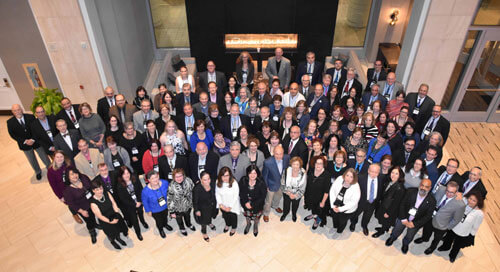In This Section
The National Association for Temple Administration (NATA) serves as the premier professional organization for executives, administrators, and managers within synagogues. Founded in 1941 and affiliated with the Union for Reform Judaism (URJ), NATA boasts almost 500 members who represent synagogues across the United States, Canada, and Australia. Our ongoing mission is to offer professional guidance and growth opportunities while upholding the ethical and integral principles of our Judaic tradition. By working together, we make sure that synagogues—the cornerstone of our Jewish community—are run by devoted people who offer strong and fundamental administrative leadership.
NATA prepares and inspires synagogue management professionals to serve and lead congregations with excellence by:
- Enriching members' professional and personal development
- Serving as the voice of synagogue management
- Advancing and promoting the profession
To fully support its members, NATA offers:
- Regular webinars and annual conferences featuring the latest information on management techniques concerning facilities, finance, fundraising, human resources, membership, office systems personnel, public relations, and security.
- A social networking tool to openly connect and engage with other NATA members.
- Bi-annual resident seminars which provide in-depth courses on topics related to all areas of synagogue administration, Judaic studies, and Hebrew instruction.
NATA programs offer participants valuable opportunities for networking, fellowship, and professional growth.
History of NATA
1941
Irving I. Katz, FTA of Temple Beth EI in Detroit, and 16 Temple secretaries form National Association of Temple Secretaries (NATS) to provide fellowship and mutual support in their efforts to improve synagogue management.
April 30, 1941. Union of American Hebrew Congregations (UAHC) adopts resolution in formal recognition of NATS.
1943
NATS offers field service to congregations without professionals.
Publication Committee established for preparation of manuals on matters pertaining to synagogue management. Irving I. Katz, founder of NATS and first president.
1951
Eastern Regional Convention held in New York. Decision is made to hold annual conferences.
1952
S.D. Schwartz elected to newly created position of Chairman of the NATS Executive Board.
1956
Two of eight Congregational Surveys published with UAHC by Max Feder, FTA.
- Survey 1: Congregation Budgets and Membership Income.
- Survey 2: Religious Services and Ceremonies.
1957
Survey 3 is published: Congregation Boards and Committees.
1958
Survey 4 is published: Temple Facilities and Their Uses.
1959
UAHC Biennial Convention held in Miami Beach, FL. NATS, now 100 members strong, adopts a new name- National Association of Temple Administrators (NATA).
1960
NATA offers 10- week course on synagogue administration at HUC-JIR building in New York.
Survey 5 is published: Cemetery Operation and Procedures.
1961
Certification program for Fellow in Temple Administration (FTA) approved at NATA Annual Convention. Under the administration of a board composed of members from NATA, UAHC and CCAR, the certificate program requires a rigorous course of study, an examination and preparation of an original thesis.
Under direction of NATA President Nathan Emanuel, members adopted "General Principles for Professional Service and Standing."
Survey 6 is published: Temple Finances and Membership Incomes.
1962
Publication of Successful Synagogue Administration (NATA with UAHC).
First issue of the NATA Journal published.
1963
First FTA exams are offered - 14 candidates take and pass the exam.
Survey 7 published: The Temple Program and the Temple Facilities.
1966
Albany, New York. NATA's 25th Anniversary is celebrated at the annual convention.
Survey 8 published: The Senior Citizens Programs in Our Temples.
1971
Jerusalem, Israel. First International Conference of Jewish Communal Service in recognizing the role of Synagogue Administrator.
1984
2000 copies of the Temple Management Manual, edited by Julian Feldman, FTA, Henry Fruhauf, FTA and Myron E. Schoen, FTA, published by UAHC Press as a reference guide for Reform Congregations.
1987
NATA begins providing professional placement service for Temple Administrators and maintaining its own resource bank.
1988
First supplement of the Temple Management Manual is printed-200 pages edited by Julian Feldman, FTA.
1991 - NATA's Golden Anniversary
50th Anniversary of NATA with 350 members. At the UAHC Biennial in Baltimore, NATA leads workshops in synagogue administration.
In this golden year, HUC- JIR begins offering a Masters of Arts in Jewish Communal Service with a specialization in synagogue management. NATA provides scholarship funds, internships, and instructors for the program.
2001
NATA, with more than 400 members, remains committed to improving the management of Reform synagogues and to support professional administrators through workshops, annual conventions, publications, consultations, certification programs and the NATA website.
2003
Scholarships are granted to NATA members in good standing for NATA conventions and educational opportunities.
2005
Board term limits are established.
2006

NATA's relationship with the North American Association of Synagogue Executives (NAASE) is enhanced with an opt-in courtesy option for accessing resources, made available by both organizations for the other.
2007
Leadership development program enhanced for new board members.
NATA Emergency Fund is established.
2008
Eligibility criteria for becoming a Regular member of NATA is revised.
NATA Investment policy is adopted.
2009
NATA gets a new look with updated logo and branding.

2013
The Board affirms the work of the NAASE/NATA Joint Taskforce for ongoing collaboration between the two organizations.
NATA is invited by the URJ to join "The Tent" to share resources as a means to enhance our work and to support Reform Judaism and NATA's relationship with the URJ.
NATA passes a resolution to review policies affecting salary continuation when employees leave due to downsizing, reorganization or other reasons unrelated to cause.
NATA commits to expanding the reach of association benefits to all URJ affiliated congregations with a renewed focus on eliminating barriers to membership due to an organization’s limited financial resources.
NATA votes to provide financial support to the URJ Dues Policy Review Task Force on their work with Grant Thornton for an immediate statistical study that will assist in the current evaluation of the MUM system.
2015

The first NATA Executive Director, Michael Liepman, is hired.
2016
NATA Code of Ethics is established.
2017
NATA celebrates its 75th anniversary in Boston, MA in a joint conference with NAASE.

2018
NATA formal Operating Procedures are established by the Board of Directors.
2021

NATA Executive Director, Michael Liepman, retires. Paula Markovitz is hired as NATA's second Executive Director.
2022
Membership eligibility criteria reviewed and updated for all levels of membership.
Special Task Force is established to:
- Assess NATA’s professional development program.
- Determine what if any changes are needed.
- Create an infrastructure for implementing change and sustaining a dynamic model of professional development programming to meet the needs of NATA members now and into the distant future.

